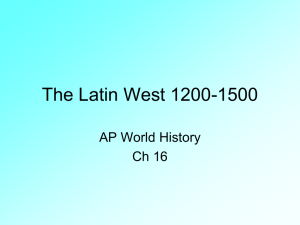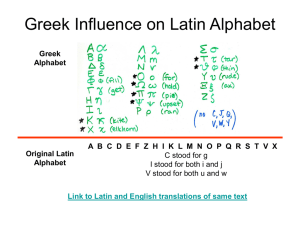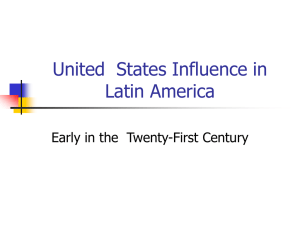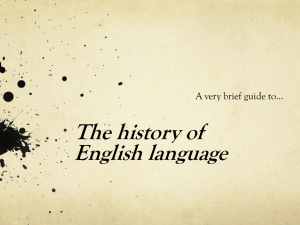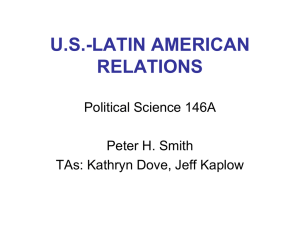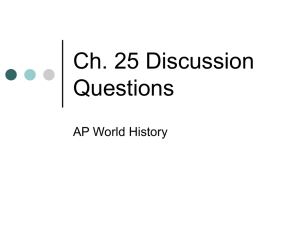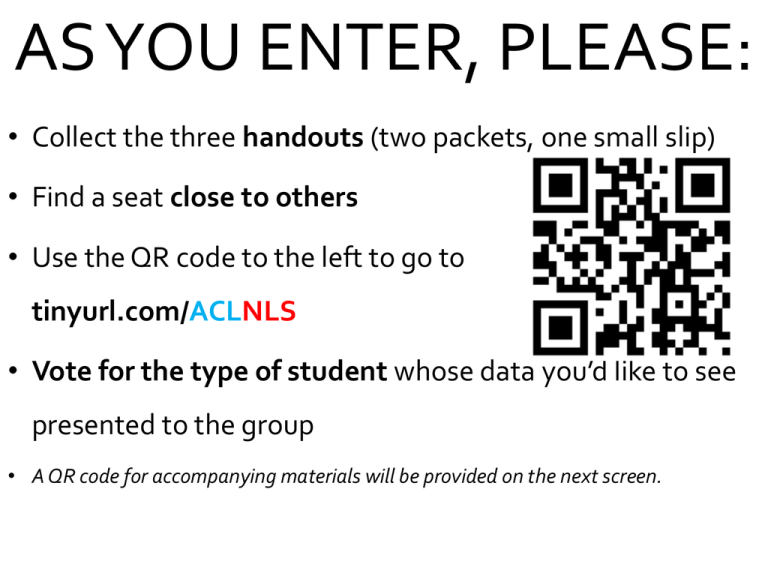
AS YOU ENTER, PLEASE:
• Collect the three handouts (two packets, one small slip)
• Find a seat close to others
• Use the QR code to the left to go to
tinyurl.com/ACLNLS
• Vote for the type of student whose data you’d like to see
presented to the group
• A QR code for accompanying materials will be provided on the next screen.
Elliott Goodman
Teachers College, Columbia University
www.NationalLatinSurvey.com
elliottgoodman@gmail.com
NationalLatinSurvey2013@gmail.com
ACL Institute
Williamsburg – June 28, 2014
Your sine quā non
Needs Analysis
National Latin Survey background
National Latin Survey results
Reactions
What do your students want?
Thinking critically about curriculum
Thank yous
Final thoughts
What is the central goal of your Latin class? Be
specific. (90 seconds)
Optional prompt:
What one knowledge/skill/experience MUST students have?
Share with a group and compare. (90 sec.)
How do your goals differ? What differences will
there be in the classroom? (2-3 min.)
To describe the goals of a
second/foreign language course or
program, a recognized procedure in the
process of program design was to carry
out a needs analysis of the kinds of
language needed by the student for
their real world purposes.
Van den Branden, K., Bygate, M., & Norris, J.M. (2010). Task-based language
teaching: introducing the reader. In Task-based language teaching: A reader.
Philadelphia: John Benjamins Publishing Company.
Who are you?
Why do you teach Latin?
Why does your school administration offer Latin?
Why do your students’ families want them to learn Latin?
Why do you want students to learn Latin?
Why might future employers want employees who have
studied Latin?
What do students need in order to say they have been
successful in their study of Latin?
What is a student’s favorite part of studying Latin?
What is the most beneficial part of studying Latin?
Abstract reasons
Concrete reasons
Language-specific reasons
Needs
Analysis
Summative
Assessment
Formative
Assessments
Scope &
Sequence
(Curriculum)
Course
Syllabi
What
do the
Needs
stakeholders
want?
Analysis
Establishing the goal
How effective was
Summative
the entire
Assessment
experience?
Make adjustments
How effective is the
planned
curriculum?
Formative
Assessments
Make
adjustments
& mala
ab ovōScope
usque ad
Sequence
Establishing
how to get
to the goal
(Curriculum)
(big picture)
What are the stages?
Establishing
how to get
Course
toSyllabi
the goal
(details)
1921-1924
ACL, Andrew West, legions of PhD students
Latin students: 940,000. Other LOTE: 926,000
Sample size:
8,595 teachers
1,313 schools
750,000 tests
150,000 students
Reading comprehension, English vocabulary,
translation skills, teaching methods, etc.
These results are based on responses from
8,990 students.
There are approximately 230,000 Latin
students in the U.S, based on data from the
Center for Applied Linguistics and the
National Latin Exam.
Teacher and program data is not presented
here.
All reported results are preliminary.
School Type
Public (68.2%)
Sex
Private (13.6%)
Catholic (12.1%)
Female
(49.5%)
Charter/Magnet (3.2%)
Male (50.5%)
Religious (other than
Catholic) (2.3%)
Home/Other (0.5%)
School Requirement
Yes (19.7%)
No (80.3%)
Who chose?
Student
(59.6%)
Parent (6.2%)
Student with
Parent (15.8%)
School Officer
or Other
(18.5%)
Grade Level
Years of Study
2,500
2,500
2,000
2,000
1,500
1,500
1,000
1,000
500
500
0
0
1.
2.
3.
4.
5.
6.
7.
8.
9.
10.
11.
12.
13.
14.
Learn vocab for the SATs
15. Learn a new way of looking at
Learn how to translate well
world
Improve my English skills
16. Learn about ancient warfare
Learn about ancient history
17. Connect to an ancient
I like ancient mythology
civilization
Learn how to speak Latin
18. Be different from other kids
I like the teacher
19. I am required to
Learn life skills
20. b/c of a book/TV/movie
Read Latin without translation 21. b/c my friends take Latin
Study Latin grammar
22. b/c a family member took Ltn.
Read Latin with translation
23. I don’t want to speak in lang.
Latin is just awesome!
class
Read ancient literature
24. Connect with my religion
Prepare me for a job
Increase English vocab
11. Understand modern culture
Improve English skills
12. See connections between
Stand out on college apps
the U.S. and ancient Rome
Learn to think critically
13. Learn vocab of a Romance
Learn translation strategies
lang.
Learn to recognize patterns 14. Connect with people who
Understand lit more deeply
lived 2,000 years ago
Learn world history
15. Be part of an unbroken
Prep to learn another
3,000 year tradition
language
16. Understand Christianity
10. Read a text in its original
more deeply
lang.
1.
2.
3.
4.
5.
6.
7.
8.
9.
1.
2.
3.
4.
Mythology
English vocabulary
Latin vocabulary
Roman games & spectacles
(e.g. chariot races, gladiators)
10.
11.
(e.g. kings, Punic Wars, Caesar)
12.
13.
5.
6.
Translation skills
Ancient daily life
14.
7.
Construction & architecture
16.
17.
9.
History: military
Latin grammar
Archaeology
(e.g. coins, stratigraphy, carbon dating)
(e.g. Roman clothing, houses, religious 15. Literary devices
practices)
(e.g. meter, alliteration, chiasmus)
(e.g. roads, aqueducts, temples)
8.
History: Medieval
History: Republic
Vocab/skills to prepare me for
a specific job
History: Roman Empire
(e.g. Augustus, Marcus Aurelius)
Art history
History: Early Christian
(e.g. Augustine, Perpetua)
18.
19.
Specific passage of anc. lit.
Christian Bible and/or Mass
52.8% I will take all the Latin courses my school currently offers.
37.8% I will take Latin at the next level. (e.g. high school or college)
34.2% I will use Latin in my job in some way.
31.6% I will study another language.
28.1%
I will complete my foreign language requirements and then
stop studying Latin.
I plan on reading my favorite Latin poems/texts outside of class
18.5%
in English or another language.
16.3% I will stop taking Latin as soon as I am able.
I plan on reading my favorite Latin poems/texts outside of class
15.3%
in Latin.
10.8% I will use Latin for religious purposes.
9.9%
I will major or minor in Classics in college.
3.8%
I want to study Latin more but cannot because my high school
does not offer it.
Your thoughts
What does this mean for assessment?
What skills are our assessments measuring?
How does this match what skills students want?
NLE, AP, IB, ALIRA, SAT II, SCRIBO, etc.
What does this mean for instruction?
How can you implement a needs analysis?
When?
What questions will you put on it?
How will use the data?
Get to the core, break the mold.
What does it mean to teach mythology? Does the Aeneid count?
Teaching vocab does not require vocab lists or flash cards.
Etiology of reasons – where do students get their ideas of
what they want from Latin class?
Why “SAT vocab?,” why translate, why speak?
Think about tasks, skills, and content knowledge as discrete
items that can be recombined in an infinite number of ways.
Technology that does the same thing as paper resources
(e.g. Quizlet) is not really innovation, it’s just new packaging.
Dr. Kirby Grabowski
Mail room folks at TC
Survey construction team:
Sally Davis (NLE)
DM & KS (CA), RP (GA), LF (MA), BW (NY), JR
(WA)
CANE, ACL, CAAS, LBP, RogueClassicist
1,000+ teachers
10,000+ students
Suggested resources:
Task-Based Language Teaching: “A task-based approach
attempts to take learners’ language learning needs as its
starting point by interpreting them in the first place as an
answer to the question ‘why?’” (p. 165)
Van den Branden, K., Bygate, M., & Norris, J.M. (2010). Task-based language teaching: A
reader. Philadelphia: John Benjamins Publishing Company.
Contact me with questions
elliottgoodman@gmail.com
Website resources
Presentation
Preliminary data infographic
Interactive data (Tableau)
Questions and Discussion




